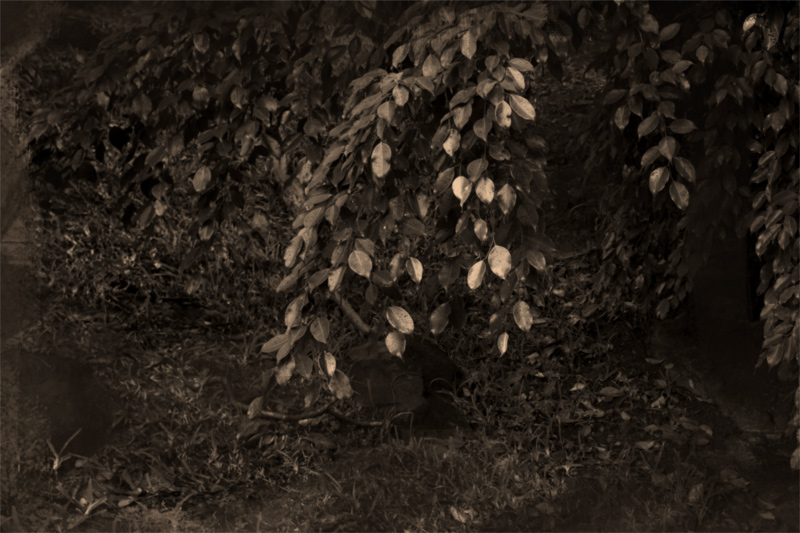SPECIAL EDITION
The Great Pretenders; Description Of Some Japanese Phylliidae From The 26th Phylliidae Convention
Special Mention, Yuji Hyakutake
Special Mention, Kiichiro Furukawa
New Culture Award, Minoru Honda
New Culture Award, Iwahashi Zenbei
The Art Of Hiroshi Abe, Master Breeder And Artist
A Very Pretty Phylliidae: Phyllium Morosus (First published in 1989)
All images by the ICZ
The GREAT PRETENDERS
An Ancient Leaf Insect
Masahiro Koishikawa
This article proposes that a Japanese daguerreotype (an old photograph) from 1861 depicts a leaf insect.
Keywords Phylliidae, Japanese, Antiquities, Photography, Eastern Bramble
 Figure 1. A Living Leaf - ‘As the wind travels through the foliage, the leaves move to their own life.’
Figure 1. A Living Leaf - ‘As the wind travels through the foliage, the leaves move to their own life.’
Japanese daguerreotype, 1861, 12.9cm x 18.9cm. Meiji Era.
Collection of the Royal family, and now in the Royal Science Museum in Kobe, Japan.
This image (Figure 1) is noted today as being the oldest surviving naturalistic image from Ancient Japan. It is now stored in the Royal Science Museum in Kobe, Japan, in an album titled “Nature” is this photograph. Titled “A Living Leaf”, the photograph shows a scene in a forest and is accompanied by an epigram that reads ”As the wind travels through the foliage, the leaves move to their own life.” The image is a rectangle wider than it is tall (12.9cm x 18.9cm). At first glance, the image reads as a genre photograph - specifically, a nature image. As such, it appears to be immediately legible, presenting us with an image of a particular tree in the forest. To PSG members in Japan, we are all too familiar with the foliage of this tree, which belongs to the Eastern Bramble, a common food plant for many cultures of Phylliidae in Japan. This is where the image gets interesting.
Usually, images of botany, which have a long history in Japanese art, can be interpreted using written sources and parallels with later folklore. But the nature and identity of this image remains elusive, as do words that accompany it. Were these images common in Meiji culture? It is hard to tell. Not only is there a dearth of textual material to aid interpretation, the nature of naturalistic images as a group is also obscure, as very few have survived.
It is notoriously hard to read this image but it has been interpreted by modern art historians as an “imaginary plant”. They see no creature in it. I argue that there is compelling evidence that it is a rendition of a leaf insect (which to many museum curators would indeed seem imaginary). To me, the presence of an animal is clear.
There may be little information on Meiji era nature photography, but this much we know: from its position in the album where it was found, as the last image of the album, this picture can be seen as a kind of oddity, or ‘remark’ following the typical images of flowers and trees in a nature album. It is not your usual image of nature and the photographer wanted to call the viewer’s attention to something. The Meiji era was a period where there was growing interest in science and researchers often photographed their subjects of study. But this is not merely a scientific photo. As the art of the Eastern Meiji was unusually rich, a variety of subjects and metaphoric references were present in their images. As a result, many pictures were meant to be appreciated on various levels. Using modern art-historical taste as a guide (which, it may be noted, is often quite different from aesthetics of antiquity), this image could be the favorite of a photographer that speaks beyond the perspective of the scientist.
The text provides a clue to this: it alludes to a kind of movement, though the experience is imaginary. The writing has a kind of poetic lyricism. There is more than meets the eye here. Could it not be that the photographer was trying to draw parallels between the tree and the leaf insect on a metaphorical level? Many Phylliidae species are motionless for long periods of time - like a plant or a tree. The insects’ stationary nature is also an important big factor in image-making in the early days of photography. This would allow the photographer to feel comfortable in attempting to create an image of this insect without the fear of it moving.
As in many images of antiquity - and today - attention to detail and context is often sacrificed to capture the perceived qualities of the object of interest. Instead of depicting a leaf insect against an unnatural environment - like a stark background or indoors - the photographer may have chosen to simplify things and gone for a holistic picture of the creature and the parallels it has with its natural habitat. Practically, this makes sense too. There was no close-up lens during that time, making a tighter shot of a leaf insect impossible. This could just be the tightest shot which the photographer could have gotten of the leaf insect.
Lastly, this image lacks the main attribute of a representation of nature: it is a tree with no aesthetic qualities, singled out to be shot, with no emotional attention to beauty. The Japanese - along with many cultures - have long venerated botany as nature endowed with special properties due to their all encompassing forms and mystery. I believe this is not simply an image of a tree.
Ironically, this image, with the uncertainties it provokes, mimic the many patterns of mimicry Phylliidae engage in all the time. To me, this is its greatest eloquence.
Special thanks to the Royal Science Museum for the loan of the photograph.
Copyright 2010, Institute of Critical Zoologists